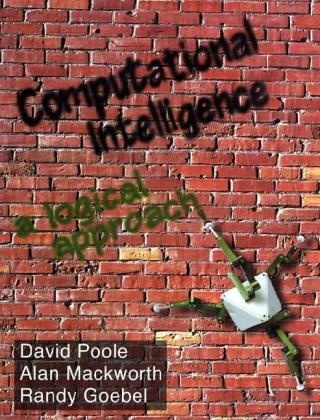Share
Fr. 169.00
Randy Goebel, Randy G. Goebel, Alan Mackworth, Alan K. Mackworth, David Poole, David I. Poole...
Computational Intelligence - A Logical Approach
English · Hardback
Shipping usually within 1 to 3 weeks (not available at short notice)
Description
This introductory textbook on Artificial Intelligence (AI) is aimed at junior/senior undergraduate and graduate level students. The book will weave a unifying theme among the core concepts that underlie the discipline of AI. While the text makes use of Prolog as its primary programming language, class testers have successfully substituted a Lisp-like pseudocode. The book encourages the student to expore, implement and experiment with a series of progressively richer logic-based
representations that can capture the essential features of more and more demanding tasks and environments. The unifying theme will feature an intelligent agent acting in its own environment. This will serve to place the core concepts of AI in a coherent and cohesive framework, making it easier to teach
and learn from. This approach will clarify and integrate representation and reasoning fundamentals and lead the students from simple to complex ideas with clear motivation. The authors have developed AI representation schemes and describe their use for interesting and popular applications, such as natural language vision, robotics, game playing, and expert systems. The manuscript has been class tested in a number of different courses in Canada, Japan, and Europe. Virtually every university and
college has an interdisciplinary course on artificial intelligence. The enrollment in such courses is rising, as many interdisciplinary programs, such as cognitive science, psychology, linguistics, engineering, medicine, business and philosophy, recommend the course.
List of contents
Preface; 1.1 What is Computational Intelligence?; 1.2 Agents in the World; 1.3 Representation and Reasoning; 1.4 Applications; 1.5 Overview; 1.6 References and Further Reading; 1.7 Exercises; 2.1 Introduction; 2.2 Representation and Reasoning Systems; 2.3 Simplifying assumptions of the initial RRS; 2.4 Datalog; 2.5 Semantics; 2.6 Questions and Answers; 2.7 Proofs; 2.8 Extending the Language with Functional Symbols; 2.9 References and Further Reading; 2.10 Exercises; 3.1 Introduction; 3.2 Case Study: House Wiring; 3.3 Discussion; 3.5 Case-Study: Repesenting Abstract Concepts; 3.6 Applications in Natural Language Processing; 3.7 References and Further Reading; 3.8 Exercises; 4.1 Why Search?; 4.2 Graph Searching; 4.3 A Generic Searching Algorithm; 4.4 Blind Search Strategies; 4.5 Heuristic Search; 4.6 Refinements to Search Strategies; 4.7 Constraint Satisfaction Problems; 4.8 References and Further Reading; 4.9 Exercises; 5.1 Introduction; 5.2 Defining a solution; 5.3 Choosing a Representation Language; 5.4 Mapping a problem to representation; 5.5 Choosing an inference procedure; 5.6 References and Further Reading; 5.7 Exercises; 6.1 Introduction; 6.2 Knowledge-Based System Architecture; 6.3 Meta-Interpreters; 6.4 Querying the User; 6.5 Explanation; 6.6 Debugging Knowledge Bases; 6.7 A Meta-Interpreter with Search; 6.8 Unification; 6.9 References and Further Reading; 6.10 Exercises; 7.1 Equality; 7.2 Integrity Constraints; 7.3 Complete Knowledge Assumption; 7.4 Disjunctive Knowledge; 7.5 Explicit Quantification; 7.6 First-order predicate calculus; 7.7 Modal Logic; 7.8 References and Further Reading; 7.9 Exercises; 8.1 Introduction; 8.2 Representations of Actions and Change; 8.3 Reasoning with World Representations; 8.4 References and Further Reading; 8.5 Exercises; 9.1 Introduction; 9.2 An Assumption-Based Reasoning Framework; 9.3 Default Reasoning; 9.4 Abduction; 9.5 Evidential and Causal Reasoning; 9.6 Algorithms for Assumption-based Reasoning; 9.7 References and Further Reading; 9.8 Exercises; 10.1 Introduction; 10.2 Probability; 10.3 Independence Assumptions; 10.4 Making Decisions Under Uncertainty; 10.5 References and Further Reading; 10.6 Exercises; 11.1 Introduction; 11.2 Learning as choosing the best representation; 11.3 Case-based reasoning; 11.4 Learning as refining the hypothesis space; 11.5 Learning Under Uncertainty; 11.6 Explanation-based Learning; 11.7 References and Further Reading; 11.8 Exercises; 12.1 Introduction; 12.2 Robotic Systems; 12.3 The Agent function; 12.4 Designing Robots; 12.5 Uses of Agent models; 12.6 Robot Architectures; 12.7 Implementing a Controller; 12.8 Robots Modelling the World; 12.9 Reasoning in Situated Robots; 12.10 References and Further Reading; 12.11 Exercises; Appendices; A Glossary; B The Prolog Programming Language; B.1 Introduction; B.2 Interacting with Prolog; B.3 Syntax; B.5 Database Relations; B.6 Returning All Answers; B.7 Input and Output; B.8 Controlling Search; C.Some more Implemented Systems; C.1 Bottom-Up Interpreters; C.2 Top-down Interpreters; C.3 A Constraint Satisfaction Problem Solver; C.4 Neural Network Learner; C.5 Partial-Order Planner; C.6 Implementing Belief Networks; C.7 Robot Controller
About the author
David Poole is a Professor of Computer Science at the University of British Columbia. He is known for his research on abductive and default reasoning, probabilistic inference, and relational probabilistic models, and he has recently been working on semantic science, combining ontologies, data, and rich probabilistic theories.
Alan Mackworth is a Professor of Computer Science and Canada Research Chair in Artificial Intelligence at the University of British Columbia. He is known for his research on constraint-based systems and agents, hybrid systems, and robot soccer.
Product details
| Authors | Randy Goebel, Randy G. Goebel, Alan Mackworth, Alan K. Mackworth, David Poole, David I. Poole, David Mackworth Poole |
| Publisher | Oxford University Press |
| Languages | English |
| Product format | Hardback |
| Released | 19.03.1998 |
| EAN | 9780195102703 |
| ISBN | 978-0-19-510270-3 |
| No. of pages | 576 |
| Subjects |
Natural sciences, medicine, IT, technology
> IT, data processing
Artificial Intelligence, COMPUTERS / Artificial Intelligence / General |
Customer reviews
No reviews have been written for this item yet. Write the first review and be helpful to other users when they decide on a purchase.
Write a review
Thumbs up or thumbs down? Write your own review.

